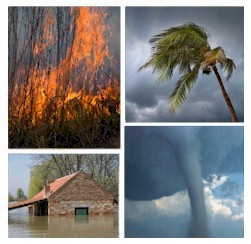|
|


Disaster Alert Systems and Services
 This section of our technical library presents articles written about Emergency Alert Systems and Disaster Recovery definitions, terms and related information.
This section of our technical library presents articles written about Emergency Alert Systems and Disaster Recovery definitions, terms and related information.
The 911Broadcast emergency notification and alert service can deliver a large number of phone calls using a network of phone systems employing digital phone lines simultaneously. Should a disaster such as a snow storm, wild fire or flood hit your area, 911Broadcast systems can alert your community quickly providing specific instructions if an evacuation is required.
This service is available using our emergency broadcasting systems. If a dangerous chemical spill occurs in your community, you can target specific areas to call. If a severe snow storm hits your area, your community can be notified of school closings or event cancellations.
FEMA History
Federal Emergency Management Agency (FEMA)
now Department Of Homeland Security
www.fema.gov
The Federal Emergency Management Agency - a former independent agency that became part of the new Department of Homeland Security in March 2003 - is tasked with responding to, planning for, recovering from and mitigating against disasters. FEMA can trace its beginnings to the Congressional Act of 1803. This act, generally considered the first piece of disaster legislation, provided assistance to a New Hampshire town following an extensive fire. In the century that followed, ad hoc legislation was passed more than 100 times in response to hurricanes, earthquakes, floods and other natural disasters.
By the 1930s, when the federal approach to problems became popular, the Reconstruction Finance Corporation was given authority to make disaster loans for repair and reconstruction of certain public facilities following an earthquake, and later, other types of disasters. In 1934, the Bureau of Public Roads was given authority to provide funding for highways and bridges damaged by natural disasters. The Flood Control Act, which gave the U.S. Army Corps of Engineers greater authority to implement flood control projects, was also passed. This piecemeal approach to disaster assistance was problematic and it prompted legislation that required greater cooperation between federal agencies and authorized the President to coordinate these activities.
The 1960s and early 1970s brought massive disasters requiring major federal response and recovery operations by the Federal Disaster Assistance Administration, established within the Department of Housing and Urban Development (HUD). Hurricane Carla struck in 1962, Hurricane Betsy in 1965, Hurricane Camille in 1969 and Hurricane Agnes in 1972. The Alaskan Earthquake hit in 1964 and the San Fernando Earthquake rocked Southern California in 1971. These events served to focus attention on the issue of natural disasters and brought about increased legislation. In 1968, the National Flood Insurance Act offered new flood protection to homeowners, and in 1974 the Disaster Relief Act firmly established the process of Presidential disaster declarations.
However, emergency and disaster activities were still fragmented. When hazards associated with nuclear power plants and the transportation of hazardous substances were added to natural disasters, more than 100 federal agencies were involved in some aspect of disasters, hazards and emergencies. Many parallel programs and policies existed at the state and local level, compounding the complexity of federal disaster relief efforts. The National Governor's Association sought to decrease the many agencies with whom state and local governments were forced work. They asked President Jimmy Carter to centralize federal emergency functions.
President Carter's 1979 executive order merged many of the separate disaster-related responsibilities into a new Federal Emergency Management Agency (FEMA). Among other agencies, FEMA absorbed: the Federal Insurance Administration, the National Fire Prevention and Control Administration, the National Weather Service Community Preparedness Program, the Federal Preparedness Agency of the General Services Administration and the Federal Disaster Assistance Administration activities from HUD. Civil defense responsibilities were also transferred to the new agency from the Defense Department's Defense Civil Preparedness Agency.
John Macy was named as FEMA's first director. Macy emphasized the similarities between natural hazards preparedness and the civil defense activities. FEMA began development of an Integrated Emergency Management System with an all-hazards approach that included "direction, control and warning systems which are common to the full range of emergencies from small isolated events to the ultimate emergency - war."
The new agency was faced with many unusual challenges in its first few years that emphasized how complex emergency management can be. Early disasters and emergencies included the contamination of Love Canal, the Cuban refugee crisis and the accident at the Three Mile Island nuclear power plant. Later, the Loma Prieta Earthquake in 1989 and Hurricane Andrew in 1992 focused major national attention on FEMA. In 1993, President Clinton nominated James L. Witt as the new FEMA director. Witt became the first agency director with experience as a state emergency manager. He initiated sweeping reforms that streamlined disaster relief and recovery operations, insisted on a new emphasis regarding preparedness and mitigation, and focused agency employees on customer service. The end of the Cold War also allowed Witt to redirect more of FEMA's limited resources from civil defense into disaster relief, recovery and mitigation programs.
In 2001, President George W. Bush appointed Joe M. Allbaugh as the director of FEMA. Within months, the terrorist attacks of Sept. 11th focused the agency on issues of national preparedness and homeland security, and tested the agency in unprecedented ways. The agency coordinated its activities with the newly formed Office of Homeland Security, and FEMA's Office of National Preparedness was given responsibility for helping to ensure that the nation's first responders were trained and equipped to deal with weapons of mass destruction.
Billions of dollars of new funding were directed to FEMA to help communities face the threat of terrorism. Just a few years past its 20th anniversary, FEMA was actively directing its "all-hazards" approach to disasters toward homeland security issues. In March 2003, FEMA joined 22 other federal agencies, programs and offices in becoming the Department of Homeland Security. The new department, headed by Secretary Tom Ridge, brought a coordinated approach to national security from emergencies and disasters - both natural and man-made. Today, FEMA is one of four major branches of DHS. About 2,500 full-time employees in the Emergency Preparedness and Response Directorate are supplemented by more than 5,000 stand-by disaster reservists.
As it has for more than 20 years, FEMA's mission remains: to lead America to prepare for, prevent, respond to and recover from disasters with a vision of "A Nation Prepared." At no time in its history has this vision been more important to the country than in the aftermath of Sept. 11th.

Emergency Phone Dialers
DSC now offers an affordable and expandable emergency phone dialer and voice broadcasting (VB) analog phone system. This 4 line auto dialing system includes our voice message and broadcast Wizard software or comes optionally with our comprehensive software development toolkit.
You can program your own system or we can provide you with a custom message broadcasting application. These applications can be easily ported to our digital T1 phone system (PACER) when your call volume requires a larger system.
This entry level system can be easily expanded by adding agent lines and software to support a small response center including inbound emergency call handling and normal outbound dialing.
DSC provides voice broadcast software including our VB wizard development tool for creating custom phone applications. This wizard guides you through each step when defining your VB applications. Informational phone applications can be developed quickly. Simply record your phone prompts and fill in the blanks.
|
|
|




 This section of our technical library presents articles written about Emergency Alert Systems and Disaster Recovery definitions, terms and related information.
This section of our technical library presents articles written about Emergency Alert Systems and Disaster Recovery definitions, terms and related information.

